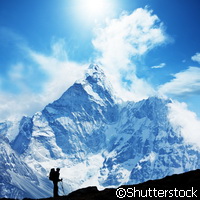Study finds there's still hope for Himalayan glaciers
The world is becoming increasing concerned about the threat of an upcoming water shortage, leading to its very own crisis. However, it now appears as if previous fears regarding the Himalayan glacier may have been unduly warranted, according to a new international study. The results are an outcome of the HIGHNOON ('HighNoon: adaption to changing water resources availability in northern India with Himalayan glacier retreat and changing monsoon pattern') project, which received EUR 3.3 million under the Environment Theme of the EU's Seventh Framework Programme (FP7). Researchers led by the University of Zurich in Switzerland have discovered that the Himalayan glaciers are in better shape than previously thought. The scientists claim that previous predictions made in the Intergovernmental Panel on Climate Change (IPCC) overstated the decline of the Himalayan glaciers. The state of the Himalayan glaciers is vitally important, considering that several hundreds of millions of people in Southeast Asia depend, to varying degrees, on the freshwater reservoirs that are provided to them. Given this significance, researchers believe that it is important to detect the potential impact of climate changes on the Himalayan glaciers at an early stage. For this reason the researchers teamed up with the European Space Agency to undertake the most up-to-date satellite surveying, revealing that the glaciers in the Himalayas and Karakoram cover a total area of approximately 40 800 square kilometres. While this is around 20 times larger than all the glaciers of the European Alps put together, it is as much as 20% smaller than was previously assumed. Lead scientist Tobias Bolch, who conducts research at the University of Zurich and Dresden University of Technology in Germany, mainly put this down to erroneous mappings in earlier studies. From this survey, the team concluded that the glaciers in the Himalayas are declining less rapidly than was previously thought. 'The detected length changes and area and volume losses correspond to the global average,' explained Dr Bolch, summarising the new results. 'The majority of the Himalayan glaciers are shrinking, but much less rapidly than predicted earlier.' For the purposes of their study, the scientists considered all the existing measurements of length, area and volume changes, and mass budgets. However, it should be noted that continuous measurement data series do not go back further than 10 years. The researchers recorded average length decreases of 15 metres to 20 metres and area decreases of 0.1% to 0.6% per year in recent decades. Based on their analyses, the researchers assume that glacier shrinkage will not have a major impact on the water drainage of large rivers like the Indus, Ganges and Brahmaputra in the coming decades. Despite the partial all-clear for the Himalayan glaciers, however, Dr Bolch advised caution: 'Due to the expected shrinkage of the glaciers, in the medium term we can expect a greater variability in the seasonal water drainage. Individual valleys could dry up seasonally.' That said, the scientists do see considerable hazard potential from outbursts of glacial lakes. Dr Bolch and his colleagues also see a very serious threat to the local population in newly formed or rapidly growing glacial lakes. The deluge of water and debris from potential outbursts of these lakes could have devastating consequences for low-lying regions. According to the scientists, increased efforts are urgently needed to monitor the lakes as well as changes in the glaciers and the climate in the Himalayas.For more information, please visit:HIGHNOON:http://www.eu-highnoon.org/Science:http://www.sciencemag.org/
Countries
Switzerland

